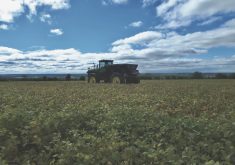Agriculture is always in search of the next innovation, but as most growers learn — some, the hard way — there is no silver-bullet solution. If you’re going to change things for the better, it’s going to take time, effort and likely a departure from the norm.
Yet with lower crop prices, growers are also more open-minded about change, plus there’s a renewed interest in soil health and sustainability, driven partly by soil-test studies that reveal fertility and organic matter are dropping in many parts of Eastern Canada.
Read Also

Agronomists share tips for evaluating new crop products and tech: Pt. 3
With new products, new production practices and new technology converging on the agriculture industry at a frenetic pace in recent…
So all sorts of questions are back on the table, including some unexpected ones. And perhaps most unexpected of all is, can conventional row-crop growers learn anything useful from organic production methods?
The quick and easy reply is, “Yes.” The more in-depth reply is, “Yes, but it depends on what you’re trying to accomplish.”
In fact, some organic strategies have already made the crossover. Cover crops, for instance, were mainly a holistic strategy a generation ago, one of the simpler choices from the list of organic practices that includes composting, mechanical weed management systems, trap cropping and the introduction of bio-control agents such as predatory or beneficial species.
To learn more, Country Guide sat down with the operators of two farms, one an organic operation, and another that began incorporating a more organic approach two years ago.
Dave Hunter and Bob Kerr
Kerr Farms and Wolfe Creek Organic Farms, Chatham, Ont.

Few farmers have a keener knowledge of conventional and organic production systems than Dave Hunter and Bob Kerr, who operate both a conventional and an organic farm just outside Chatham, Ont.
It’s a definite advantage, they agree, that they’re primarily a horticultural operation. They’ve been producing fruits and vegetables in the Chatham area for decades. In fact, they made the transition to organic for part of their production in 2000, renting a field in 2001 from a neighbour who had been growing organic already, and then they built from there.
At the time, prices on conventional crops were low, which spurred their search for a way to differentiate the farm’s production and to generate higher revenues.
“It was an opportunity to produce more vegetables in our fields,” says Hunter, adding that the operation was already growing tomatoes. “We had an opportunity to grow more tomatoes organically for our customer, and they were value-added and we were looking to create some stability.”
At the time, revenues in organic markets were more stable than conventional, and Hunter says prices for organic ran more on their own merit. There were also small numbers of people converting to organic with a steady growth in demand, and the outlook seemed positive.
Today, he still says that organic production isn’t for everyone, nor is it always feasible for growers in traditional row-crop regions of Ontario and Eastern Canada to add a horticulture crop as a stepping stone to organic.
Even so, there are opportunities to add non-chemical or non-synthetic practices to a farm’s operation, and Kerr maintains that it’s a step in the wrong direction to look at conventional and organic as an “either/or” choice. He asks why growers can’t apply the best of both.
“We do try to apply as many possible methods from organic into the conventional — because our heart is in organic,” says Hunter. “But we do have some opportunities with some contracting and things where we’re staying conventional, so there are many practices that we use in both like cover crops and composting. We look at the biology of the soil and feeding the soil, as well as IPM and managing a few products that we can use organically.”
There are products for Hunter and Kerr to use in their operations. although they obviously aren’t always the same products. The synthetic ones for their conventional acres are more effective than the organic products but again, that doesn’t mean there aren’t shared lessons. For example, in conventional production, Hunter notes they only band-spray what they need in order to deal with the issue at hand. They don’t cover the whole soil surface. They also use variable rate technology, including RTK in their tractors for both conventional and organic. And they use cover crops everywhere they can.
Mechanical weed management
One of the trends that’s been developing in the past two years is the use of mechanical weed management tools. Some might align those closer to organic production, but there are cases where row-crop producers are using them in an organic setting. One is an abrasive weeding or “weed blasting” system being tested by the University of Illinois (see below). At Kerr Farms and Wolfe Creek Organic Farms, they use a Flame Weeder, a device they run between rows that will chemically “flame” or burn emerged weeds, but there is also a hand-held or unmanned aerial vehicle (UAV)-mounted sensor being tested at North Dakota State University.
“It’s non-selective — it’ll kill any weeds that are underneath the canopy of the actively growing crop,” says Hunter. “It controls the weeds in the row and we row-crop cultivate between the rows.” He adds that they use it at different stages of plant growth, namely prior to crop emergence and after emergence, depending on the crop being flame-weeded. In certain instances, they can also use it for insect control. “We can use it both organically and conventionally, but it’s less selective — you can injure the crop with a Flame Weeder.”
Hunter and Kerr do express their frustration with the seed, trait and chemical side of the industry, especially since the advent of GMOs and the increasing role of fungicides. Yield has become foremost, and it is vital, they agree. But a single-minded focus on yields can create problems that growers recognize, like herbicide resistance, as well as other problems that may take longer to become apparent, such as damage to what Hunter calls the soil-food web and its importance for healthy crop growth.
Organic may start with adding cover crops, but it doesn’t have to end there, Hunter and Kerr also emphasize.
“There could be opportunities in the future to sequester carbon for carbon credits, with the use of conservation tillage or cover crops, and by building organic matter in the soil,” says Hunter. “Long term, we do reap the benefits of more water-holding capacity in the soil, with higher organic matter, more of an ability to hold and retain nutrients. And hopefully with cover cropping, you keep the soil covered so you’re not washing your phosphorus and nitrogen into the lakes, especially in the Great Lakes area, where we know we’re getting these phosphorus blooms.”
Buying into organic
Among the other organic practices available to growers, use of manure and composting comes after cover crops, although in Kent and Essex County, the availability of manure can be a challenge, given the scarcity of nearby livestock operations.
“But there is more composting going on, and there’s more interest in biological inoculants — increasing the naturally occurring benefits that we can be applying to the seed, whether it’s in soybeans or other crops,” says Hunter. “It’s a natural biology and some of those are becoming more mainstream.”
As with most changes, adding an organic component to a farm operation takes patience and open-mindedness. That said, there is a determination that is shared by most innovators and early adapters. They do all they can to see the change or a new system succeed on their farms, and the same is true with organics. It will take time, patience and a determination to make small, necessary adjustments to management practices.
“You have to have a toolbox of implements, so it’s going to cost some money and there’s a big learning curve,” says Hunter.
“You’re not going to solve all the problems at once because you’re going to find new ones come along all the time,” he adds. “If you think you have it right this year or next year, there’ll be something else will pop up. So you have to be willing to adapt and change.
“It is tough, but in the end, you’ll benefit by building soil organic matter, and even on our conventional side, we use less nitrogen than most of our neighbours do, just because we’re using some of our organic methods to build the soil and get more natural nitrogen with cover crops.
Mike Belan
Belan Farms, Oil Springs, Ont.

Some 25 years ago, Mike Belan decided to cut costs on his farm by moving to no till. As he went along, however, the Lambton County grower determined he needed to accelerate the building of soil organic matter, so he opted for the organic practice of cover cropping.
What started out as an economic strategy turned into an environmental one — trying to better the soil’s characteristics.
“Indirectly, our goal will be for financial gain, producing a higher yield with fewer inputs and less environmental instability as we progress and build our soils,” says Belan, who favours the concept of working more with Mother Nature. “It pertains to using organic practices with conventional farming so that we can limit our need of herbicides for weeds and chemicals for crop protection from pests. It’s also to have the ability to control and limit the need for synthetic fertilizers by working the soil biology and building our soil organic matter to efficiently and effectively use, maintain and keep our applied fertilizers for our cash crops.”
Belan’s ideal practice is to plant a cover crop that will stay green during the winter months and easily terminate to leave the soil covered with a thick mat of residue, so the only thing capable of coming up through it will be the cash crop that’s seeded into that residue.
This not only protects the soil from the harsh environments but limits the need for pre-plant burndown treatments and in-crop applications if the residue keeps weeds at bay until the crop leaves canopy and shades out the weeds. It’s also ideal if the cover crop takes a secondary role, that of a companion crop that provides a nitrogen boost.
Asked about the percentage of growers who are using a form of organic farming in their operations, Belan believes the frequency is rather low. In fact, he sees a pendulum swing in his region towards increasing tillage and plowing, particularly cultivating between soybean harvest and winter wheat planting, a practice he just doesn’t understand.
“Bottom line, these organic practices are, in my opinion, relevant and necessary in every type of farming practice, especially with row-crop growers,” says Belan. He adds that at the very least, there’s no reason for not using cover crops. “We are depleting the soil organic matter and growing less and less diversity all the time, and many growers don’t even realize it’s happening.”

There are many objections levelled by conventional growers towards organic practices, which Belan has a hard time acknowledging. One of the more common myths Belan encounters is that use of a cover crop will help the development of weed pressure — or continued growth of the cover crop — that will hinder the cash crop’s growth. Or there’s the concern that a cover crop that has overwintered too well will cause planting issues in the spring. It means it will take another level of management to deal with these issues.
Organic still bears a stigma, notes Belan, and that comes from the years of conventional agriculture, with its emphasis on high-priced equipment, clean fields and high yields.
In his eyes, however, a strong return on investment is better than high yields, especially if a grower has to “buy” those yields.
With the use of cover crops, Belan believes there is a definite swing in the way farmers are farming, and in his view, cover cropping and the reintroduction of grazing those cover crops is a unique hybrid of the organic/conventional row-cropping methods of farming.
The bottom line is that growers need to shift their approaches, if not their mindset when considering changing practices on their farms.
Nothing happens overnight, says Belan, echoing Hunter and Kerr. And that may be the hardest concept to grasp, especially in a day and age where most growers forget the lessons learned two, three or five years ago.
“A farmer definitely needs to take it slow so as not become overwhelmed with it, especially with incorporating cover crops on their farm,” says Belan, suggesting a grower try cover crops on a piece of his best land and a piece from his worst.
Put the test area right in the middle of the farm so you can compare the two, he recommends. “And stick with simple cover crop mixes to begin with. That way you can still maintain control of it in the spring before you plant your cash crop. And don’t expect large returns right away, but over the long term.”
Weed blasters and flame weeders
Here are two pieces of technology that are gaining advocates across North America in a variety of organic and some conventional operations, although they are not necessarily suitable for every farming operation.
 Weed blasting
Weed blasting
The weed blaster is a hand-held unit being tested by University of Illinois researchers with a particular focus on organic growers. The technology sandblasts weeds using a gas-powered air compressor, which is hauled down crop rows by a walk-behind tractor. Preliminary studies indicate weed control of 69 to 87 per cent compared to non-weeded checks. University researchers have been testing “sand” composed of walnut shells, granulated corn cobs and soybean meal, among others. Used at the optimum plant growth stage, the force of the propelled grit can damage both the stem and the leaves of weeds.
There are two primary concerns in the use of this particular unit. First, the speed: the grit is propelled at better than Mach 1 (1,227 km/h), so protective eyewear is strongly advised. And since the technology has no electronic sensing to distinguish between a plant and a weed, it’s very possible to damage the crop.
- Weed blasting in kale (YouTube)
- Weed blasting in tomatoes (YouTube)
- Weed blasting plastic mulch (YouTube)
 Flame Weeder
Flame Weeder
The Flame Weeder is a technology that employs extreme temperatures to scald or overheat the weed plant’s tissues, effectively cooking the protein of the plant. It is another system that is used primarily in the organic sector, and comes in four- and five-torch configurations. Like the weed blasting technology, it’s hand-operated, running across a seed bed that is prepared and marked for planting roughly two weeks prior to the actual planting date, allowing weeds to germinate and emerge. Once the treatment is complete, the desired crop can be planted.
The key to the Flame Weeder is timing: like the weed blasting technology, the Flame Weeder cannot distinguish between weed and crop, and it is possible to damage the plants at the same time as scalding the weeds.
















